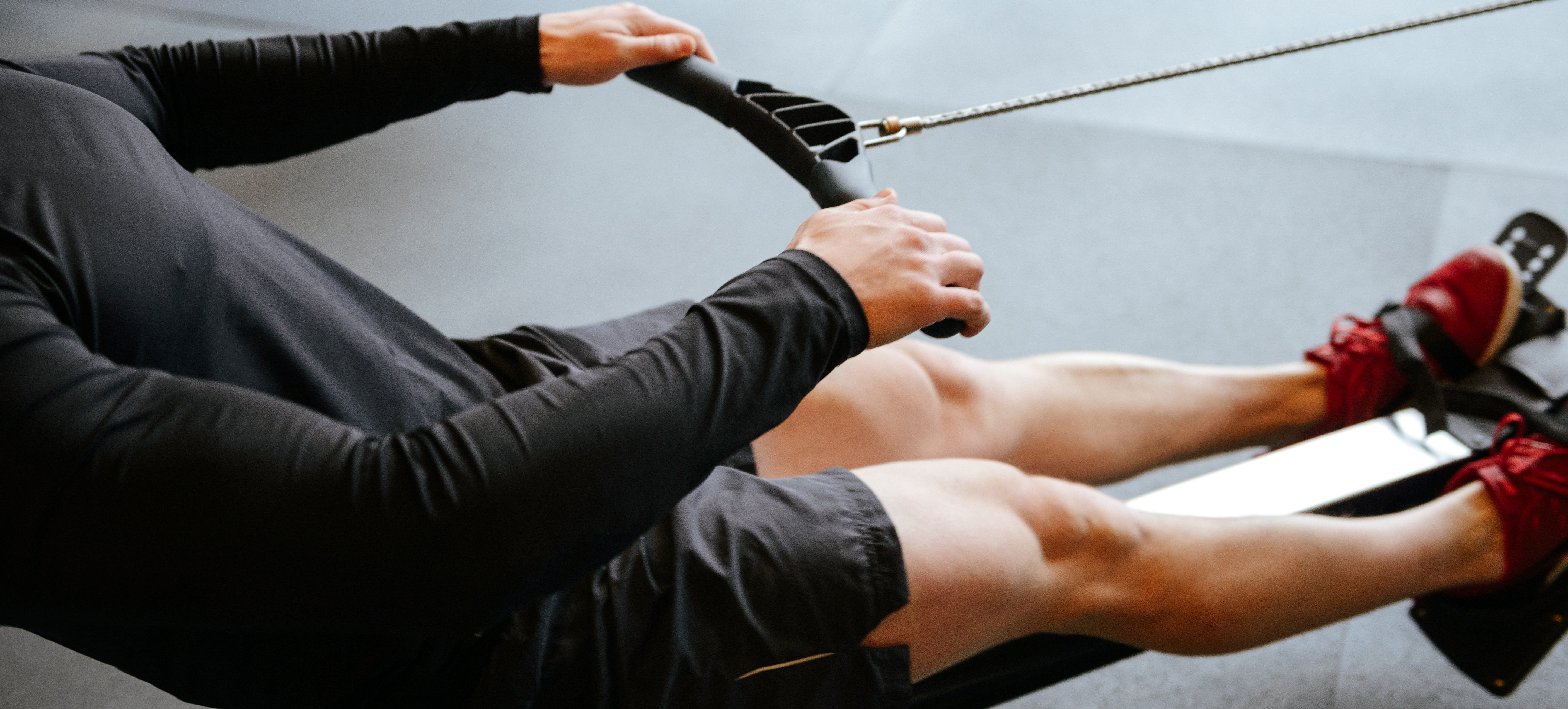
The rowing machine – it’s so hot right now.
Rowing classes are everywhere. It’s easy to find professional and Olympic athletes hyping up the machine’s ability to provide a full-body workout.
All fine and good…but how do you actually use the thing?
Welp my friend, you’ve come to the right place to find out.
Many clients in our Online Coaching Program tell us they want to start rowing, but they don’t know how. Today, we’ll explain how we get them going with row machine workouts.
Here’s what we’ll cover:
- How to use a rowing machine (with video tutorial).
- What are the benefits of using a rowing machine?
- Rowing Machine 101: Terms to Know
- The four parts of the rowing stroke.
- When to add the rowing machine to your workout.
- Should a beginner use a rowing machine? (Next Steps)
Alright, you ready?
Let’s row, row, row your rower.
How to Use a Rowing Machine (Video Tutorial)
In the video above, Coach Staci explains the ins and outs of using a rowing machine.
What? Who’s Staci?
Welp, she’s a Senior Coach here at Nerd Fitness and an all-around badass powerlifter.
She also knows a thing or two about using a rowing machine, since she’s gotten several CrossFit certs (they love the rowing machine at CrossFit).
If you’re going to learn about using a rowing machine, she’s not a bad person to talk to.
But first, let’s back up here a bit…
What Are the Benefits of Using a Rowing Machine?
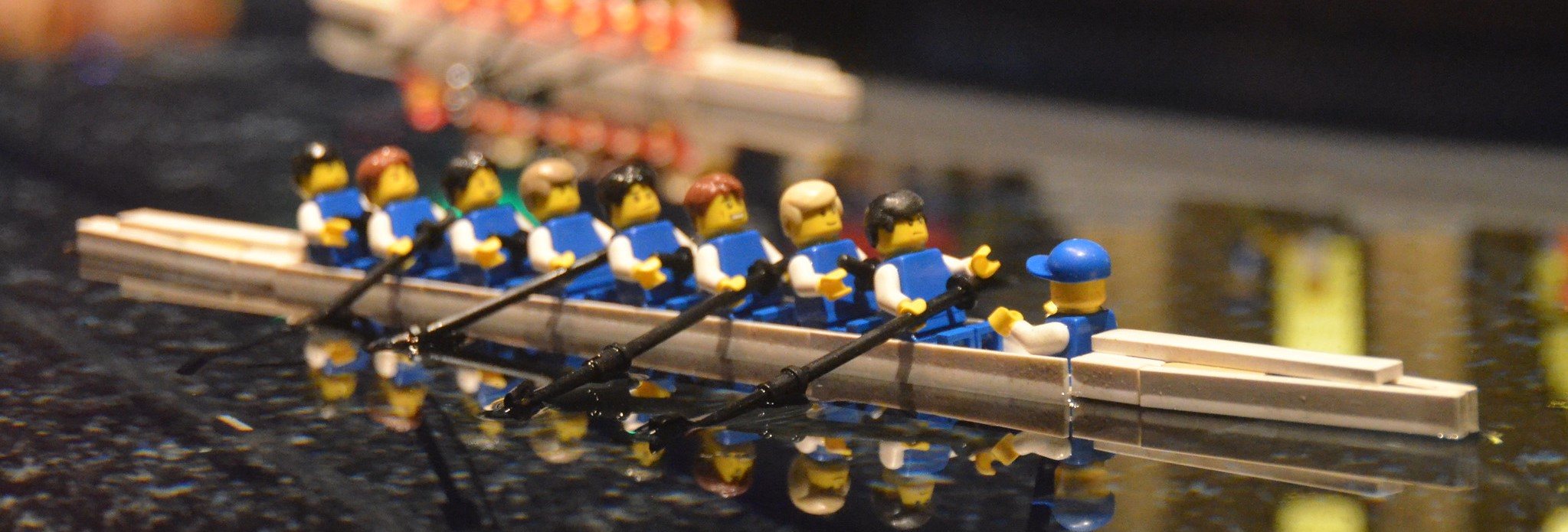
The rowing machine was originally invented for water rowers to train off-season.
You might hear the indoor rowing machine called an ergometer, or “erg” or “ergo.” They get this name since rowing machines often measure the energy produced from the workout in units of ergs.
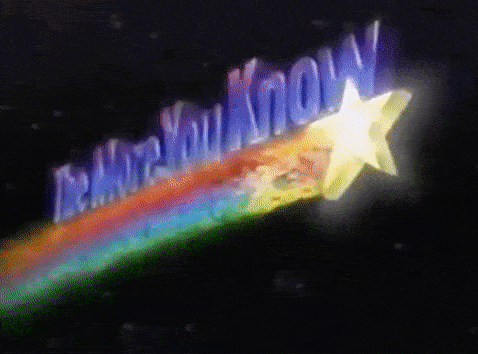
They’ve grown in popularity, because this one stationary machine offers a lot of neat features.
For example, the benefits of the rowing machine include:
- A Full-Body Workout. If we use proper rowing technique, we’ll hit every major muscle group in our body. Upper, lower, core, we’ll work it all. This is one of the main reasons they’ve become so popular.
- Low-Impact. While a workout from a rowing machine can get intense, it’s considered to be little to no impact. That’s why it’s sometimes recommended to patients with osteoarthritis.[1]
- Versatility. We can do a lot with an ergometer. We can train for duration and/or intensity. We even do a HIIT workout. Or we can combine it with bodyweight movements in a circuit. Plus, since some of them fold up, they’re perfect for those who need to train in small spaces.
Alright, let’s now go over some terminology so you know what’s what with the ergometer.
Rowing Machine 101: Terms to Know
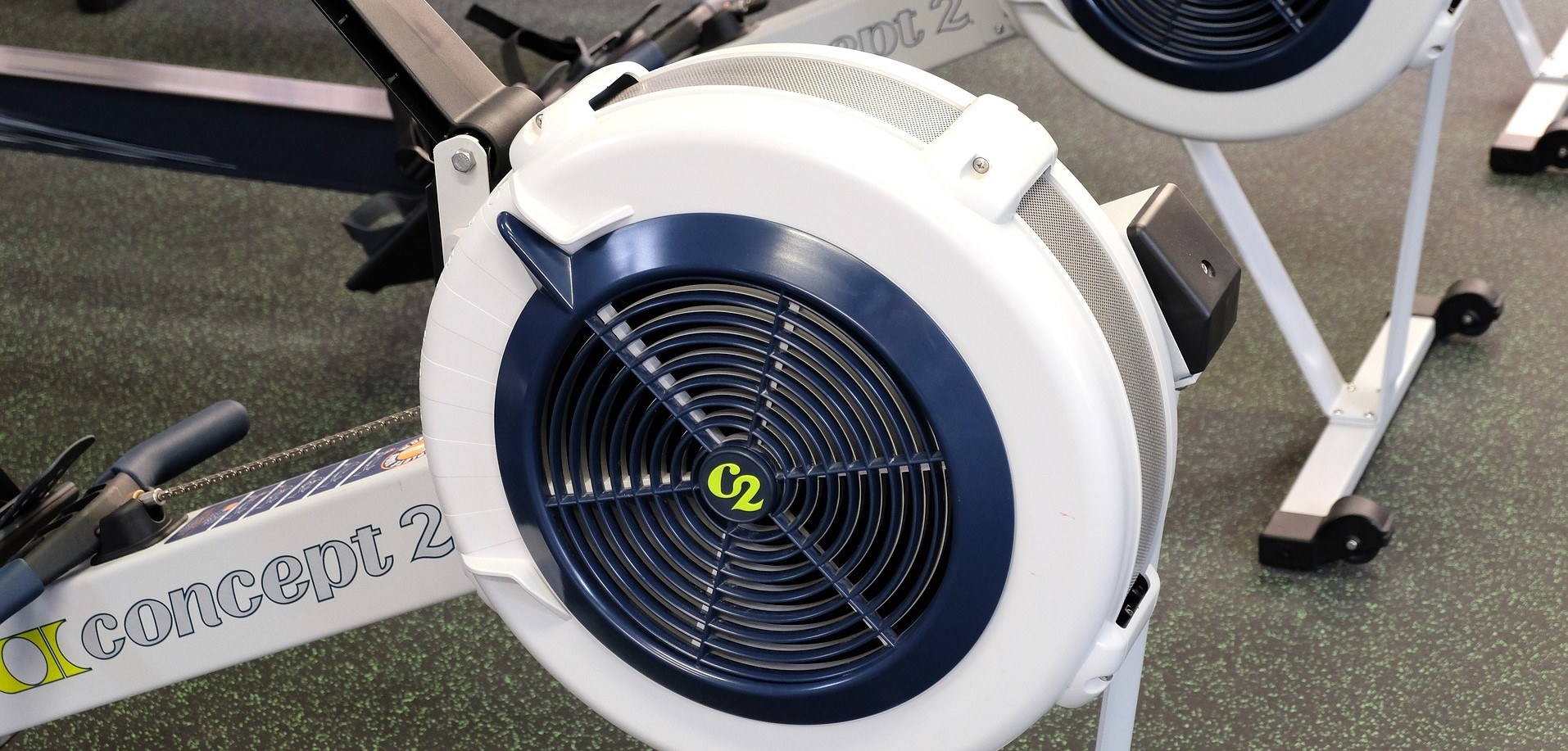
When it comes to the rowing machine, there’s some vocabulary that would be worth discussing quickly.
First, let’s chat about the rower itself.
Here Are the Parts of the Rowing Machine:
#1) Foot Plate – no matter the rower, there will be a place for you to strap your feet in.
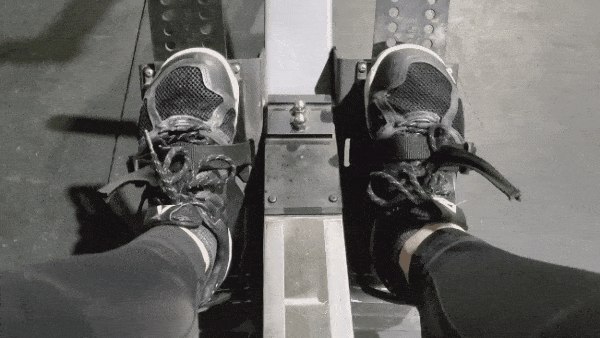
You’ll want to set your feet so that the strap goes over the ball of your foot. This will allow you to have the most powerful stroke.

You should be able to lift your heel in this position.
#2) Handle – also called “the bar.” This replicates the handles of an oar.
Your hands should be approximately shoulder-width apart.
#3) Rail – the central beam of the rower, which allows the seat to roll forward and back.
#4) Display Monitor – while these will differ from model to model, the rower will normally have a screen to show some basic info:
- Strokes per minute (Stroke Rate)
- Split Time (more on this momentarily)
- Duration of workout
Etc.
For the Concept2 model – the rower Coach Staci demonstrates above – you can hit any button and select “Just Row.”
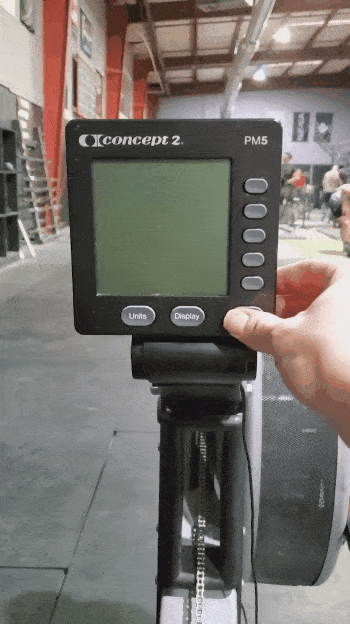
This will be the easiest way to get going.
#5) The Damper – The lever on the side of the flywheel housing (or fan cage) that controls airflow.
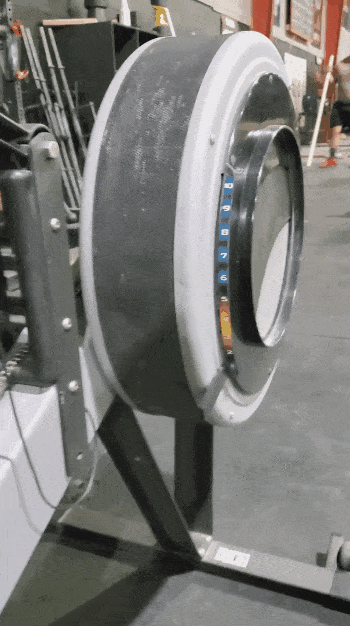
The difference in Damper settings:
- The higher the setting, the more air is allowed to flow. This requires more work to spin the flywheel.
- The lower the setting, the less air is allowed to flow. This requires less work to spin the flywheel.
Think of this sort of like bicycle gears – it affects how the rowing feels but does not necessarily reflect the resistance:
- A setting of one will feel fast and easier to pull, but you’ll need to move quickly to generate power.
- That said, cranking the damper up to ten doesn’t mean a better workout either. It just means a tougher pull – like trying to move a rowboat.
We recommended you aim for a Damper setting between 3 and 5 (which is also where most competitive rowers have it).
Note: some indoor rowers use a water tank to create resistance, so any similar Damper setting controls the amount of water moving through the system. You can still use the same recommendations for damper numbers.
More on that here:
Next, let’s talk about some terminology for the sport of rowing itself.
Rowing has been around for centuries and a lot of the vocabulary has carried over to the indoor sport.
Rowing Terms to Know:
#1) Split
Split time refers to the time it takes to row 500 meters, also known as the “split per 500.” This will likely be shown prominently on your Display Monitor.
If the number goes down, it means you’re going faster! Woot.
#2) Strokes Per Minute (SPM)
This is also called Stroke Rating and it’s exactly what it sounds like: the number of strokes you take per minute.
A higher SPM doesn’t necessarily mean you’re going faster – you can also go faster by putting more power into each stroke.
#3) Paddle (or Rest)
Normally in the sport of rowing, you never stop completely. You just row or “paddle” a little bit easier.
Sort of like you do in HIIT workouts.
However, if you need to stop completely in your workout, don’t stress it. It’s fine to even get off the rower from time to time…it’s not actually a boat.
You do you.

Next, we need to discuss the four parts of the rowing stroke, but we’ll jump to a new section for that.
The Four Parts of the Rowing Stroke
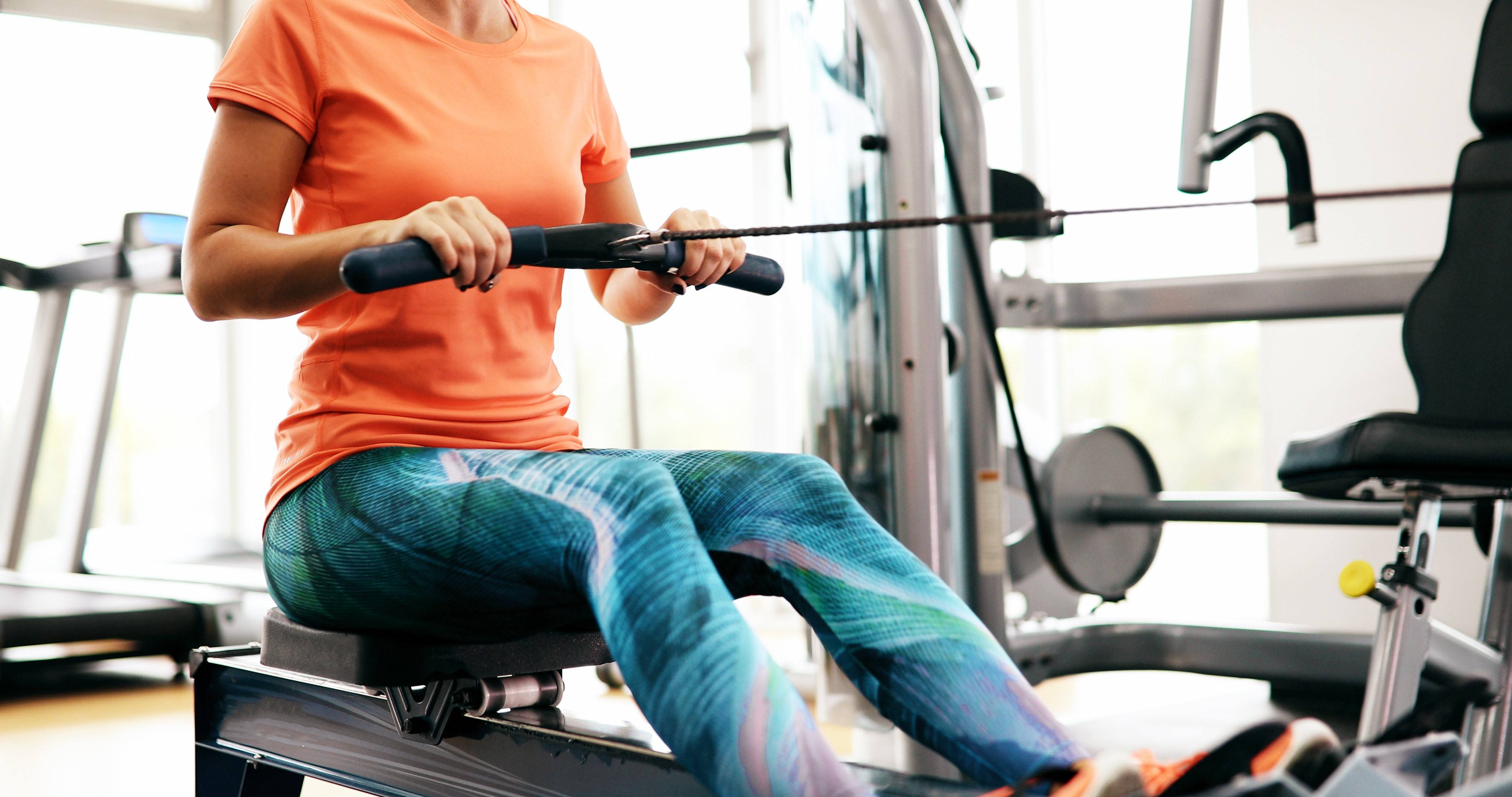
The rowing stroke is broken out into four parts:
- The Catch
- The Drive
- The Finish
- The Recovery
It’ll look like this:
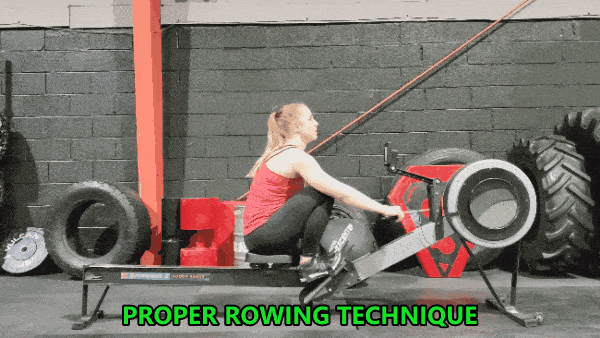
Let’s cover each.
#1) The Catch
This is the start of the stroke:
- Our knees are bent and our shins are roughly vertical.
- Our body leans forward slightly to about a 1 o’clock position and our arms are straight.
Like so:
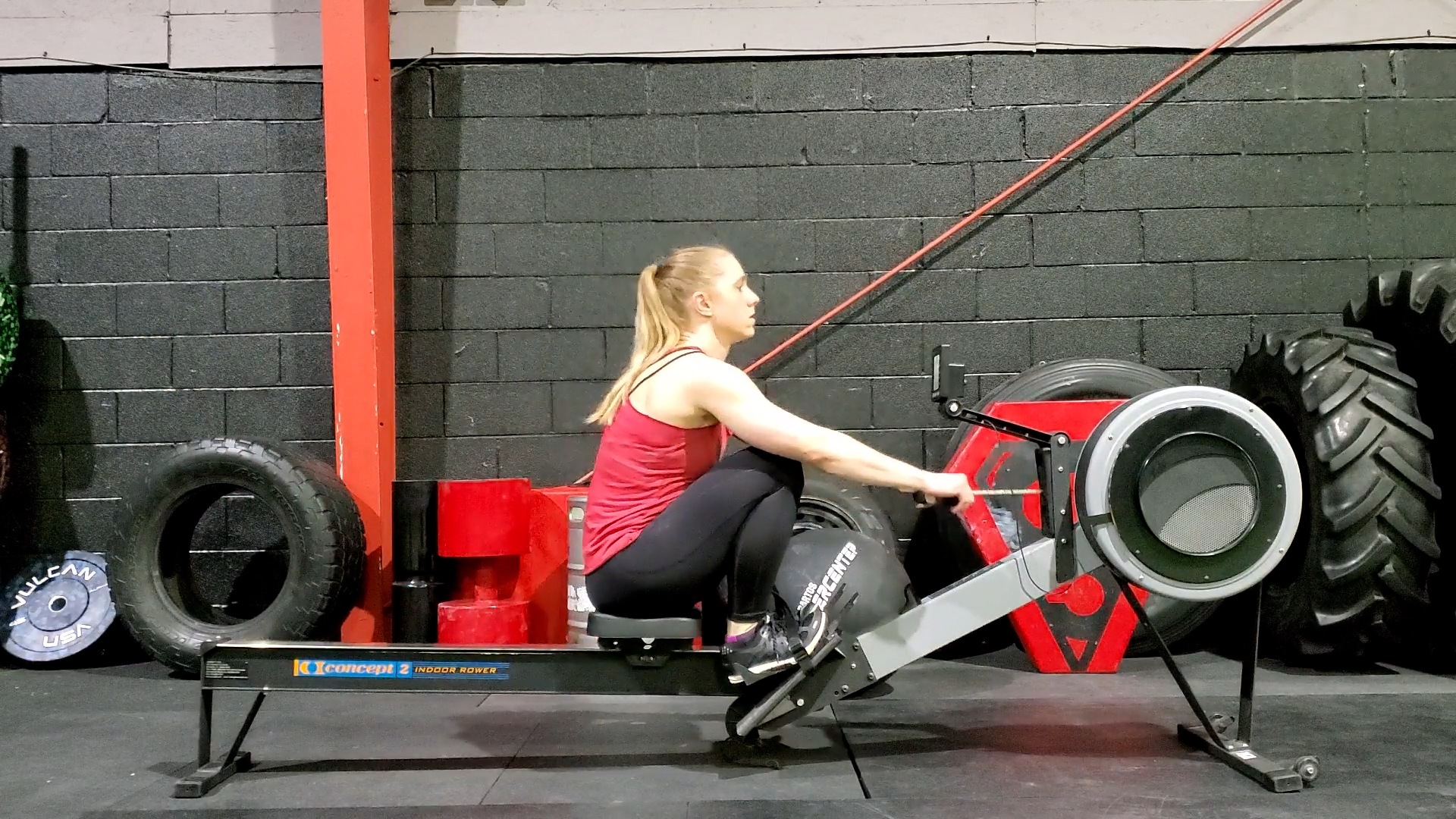
This puts us in the ideal position to generate power.
#2) The Drive
As the name would suggest, this is where we’ll be driving and generating power for the stroke.
The order in which we generate power is key:
- It should go legs first
- Then lean back with the body
- Then pull with the arms
It’ll look like this:
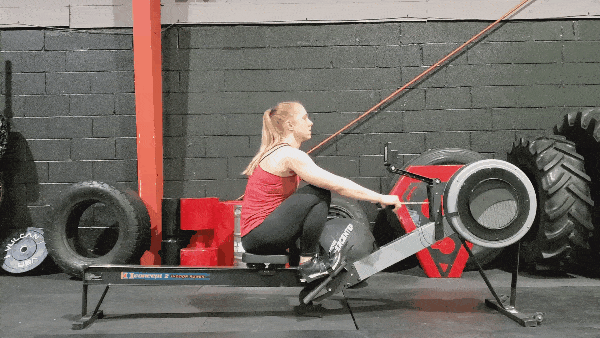
They should blend smoothly right into each other, so a good reminder is:
- Legs
- Body
- Arms
A great drill to practice the Drive:
Start with JUST the legs:
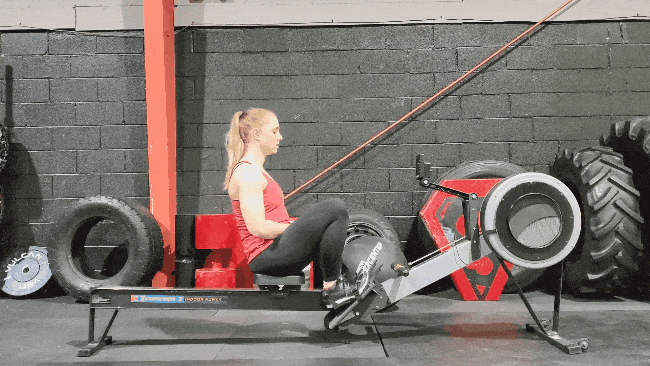
THEN the legs and a slight backward lean with the body:
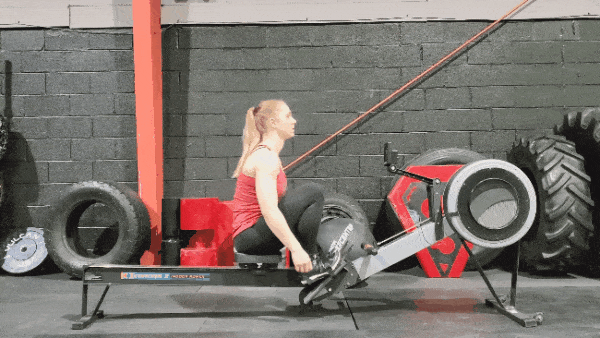
FINALLY, the legs, body, and arm pull together:
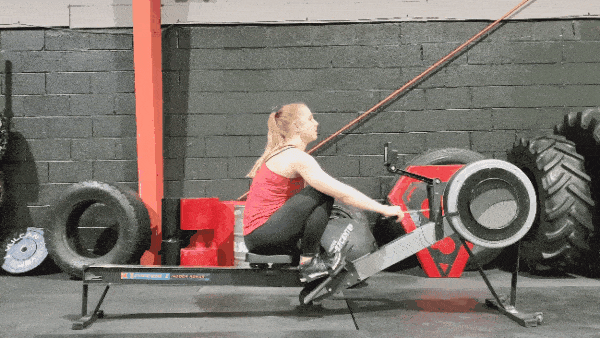
This can be done with or without the rowing handle.
Common mistakes with the Drive:
A) Pulling hard with the arms first. We’ll see the elbows bend early. This greatly decreases the amount of power we can put into the stroke.
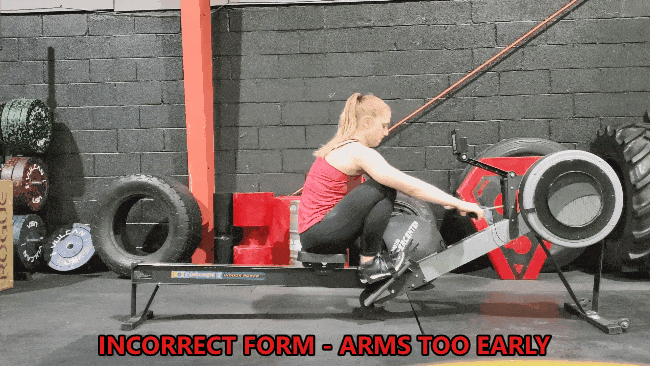
We want to keep the arms straight and wait until the handle passes the knees BEFORE we first bend the arms.
B) Letting the body pull forward while we’re driving with the legs.

Instead, we want to keep a strong and stable midsection so that we can go smoothly from the leg drive to the body lean.
#3) The Finish
This will be our position after the Drive:
- Our legs are extended and our body is leaning back slightly.
- The handle is about at our solar plexus.
- Our shoulders are down and our wrists are straight.
It’ll look like this:

A great drill to practice the Finish: just work on the arm motion.
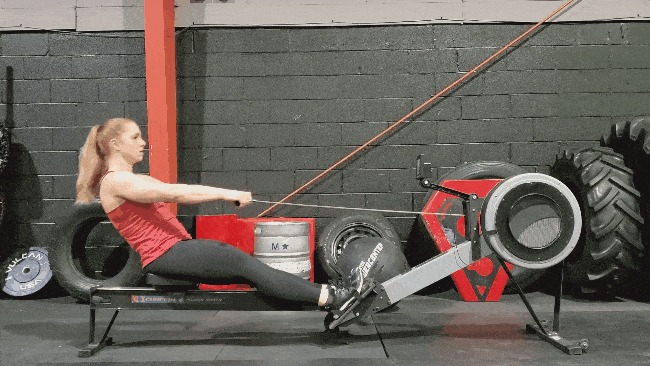
Keep the legs extended and lean back slightly. Then pull with just the arms.
Common mistakes with the Finish:
A) Shrug the shoulders up by the ears.
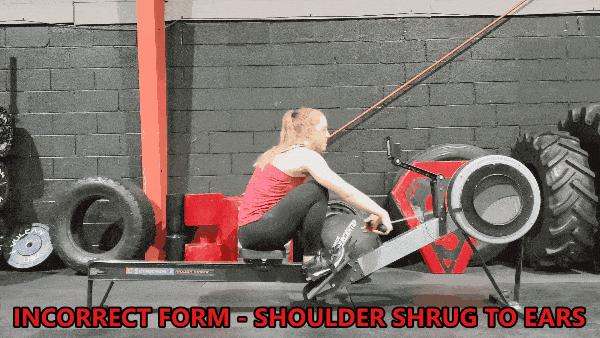
This is often accompanied by bent wrists and chicken wing arms.
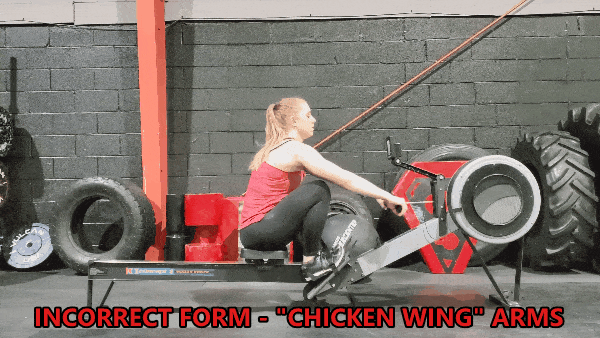
Instead, we want the shoulders down and the elbows closer to the sides, with enough space between the arms and body for a grapefruit to fit.
B) Pulling the handle too high – to the neck or face.

We want the handle down at the solar plexus, not up orbiting in the solar system!
C) Leaning back too far – we’re not trying to perform the one-person luge here!
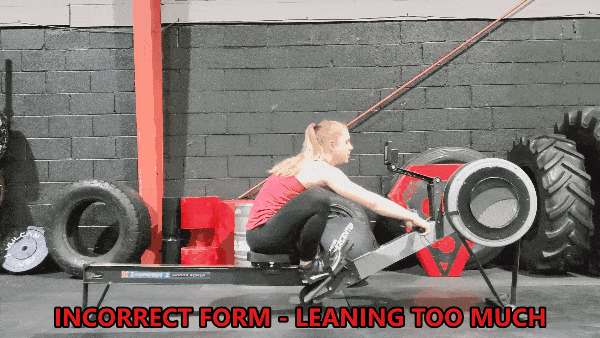
We only need to lean back slightly, at about an 11 o’clock position.
#4) The Recovery
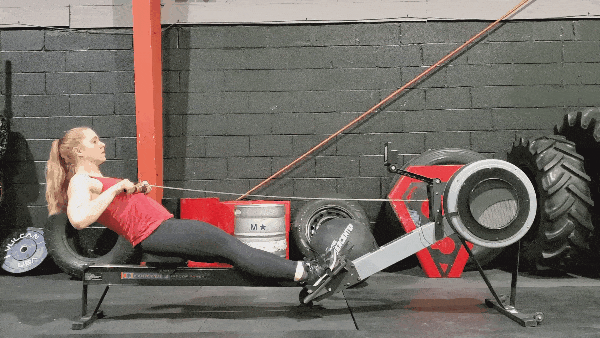
This is how we return back to the starting position.
- Just as we had a proper order for the Drive – legs, body, arms – we’ll have a proper order for the recovery by reversing it – arms, body, legs.
- Straighten the arms, then lean the body forward slightly, and finally bend the legs to head back to the Catch.
Common mistakes with the Recovery: Bending the legs too early when recovering from the stroke. You’ll know you’re doing this when you have to lift the handle up and over the knees.
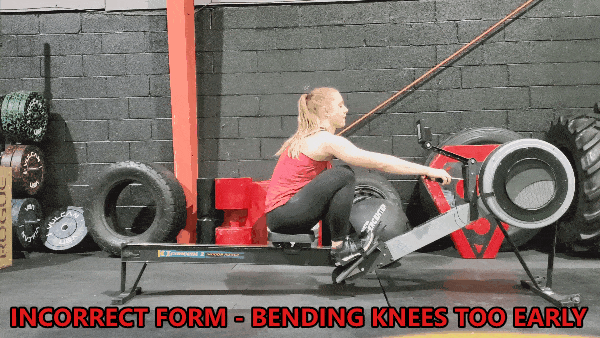
Instead, wait for the handle to PASS the knees before fully bending the legs.
There you have it, the four parts of the rowing stroke.
You’ll get better at this as you go, I promise.
Rowing is like golf: the relentless pursuit of the perfect stroke.
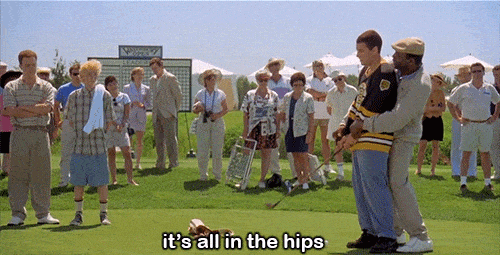
One way to check your form would be to record yourself doing a rowing stroke.
If it looks close to the gifs and videos found in this guide, you’re doing great!
Oh, and if you want an expert to review your form, you can do so in our snazzy Coaching app.
You can learn more here:
When to Add the Rowing Machine to Your Workout

A rowing machine can fit into our workout in all sorts of ways.
We can row:
- At the beginning or end of a workout routine.
- As part of interval (HIIT) or circuit training.
- For the entire workout itself.
If you want to give the rowing machine a whirl, including it as part of your warm-up wouldn’t be a bad idea. Since it’s a full-body exercise, it’s a great way to prep our body for the workout ahead.
To warm up with the rower, aim for about 5-10 minutes at a steady pace.
Once you get the hang of the rower, you can look to incorporate it with some of these ideas:
#1) Interval Training
Interval training or HIIT is all about flipping between intensity.
Going hard one moment, then resting another.
So after your warm-up, you could row intensely for two minutes, rest or “paddle” for a minute or two, then back to intensity.
A fun way to do this is to build up the duration and then pull it back with a “Meter Pyramid.”
To Row a Meter Pyramid:
- One minute of intensity, followed by one minute of paddle.
- Two minutes of intensity, followed by two minutes of paddle.
- Three minutes of intensity, followed by three minutes of paddle.
- Four minutes of intensity, followed by four minutes of paddle.
- Three minutes of intensity, followed by three minutes of paddle.
- Two minutes of intensity, followed by two minutes of paddle.
- One minute of intensity, followed by one minute of paddle.
If you start this off with a 5-minute warm-up, it’ll take about 37 minutes.
#2) Circuit Training
You could also mix in some other exercises as part of your rowing workout. Flipping between rowing and some bodyweight exercises, for example.
Here’s an example Row Machine Workout Circuit:
- Row for 500 meters
- 10 push-ups
- 10 bodyweight squats
Repeat.
We could aim for 3-4 circuits here, but even 1-2 is a great start.
#3) Steady State
This is exactly what it sounds like: rowing at a constant pace.
After a warm-up, find a pace that you can stay with. Then stay with it.
A good frame of mind here would be about 50% of your effort, but don’t overthink this.
Put on a good podcast or your favorite playlist, find a Stroke Rate you can maintain for 10-30 minutes, and get rowing.
You can pretend you’re in a competition if it helps!
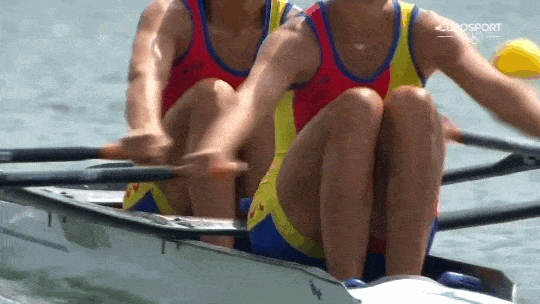
Also, mix and match! The important thing is that you’re doing some type of workout. Don’t fret if it doesn’t fit into the exact format you find here or on other websites.
For more ideas here, check out How to Build Your Own (Full-Body) Workout.
Should a Beginner Use a Rowing Machine? (Next Steps)

There you have it, my friend.
You now have everything you need to get started rowing.
Don’t overstress if you’re not doing anything 100% right as you start.
Like anything, you’ll get better at it as you go.
Plus, it’s not like you’ll be ejected into the water from an indoor rower.
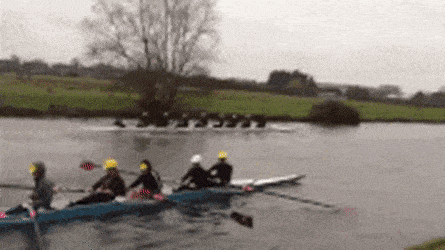
But, if down the road you do want to take it outside, there are all sorts of leagues and clubs you can join.
It could be a great way to get out and make friends!
Granted, you’ll need SOME type of body of water around you, but if you live next to a lake or large river, there’s likely a team out there that would love to meet you.
Practice indoors for a bit, then take 20 seconds of courage to put yourself out there.
What’s 20 seconds of courage?
We explain it all to you in this video:
Oh, and if you want to continue having Nerd Fitness propel your journey, here are three ways we can help:
#1) Our Online Coaching Program: a coaching program for busy people to help them make better food choices, stay accountable, and get healthier, permanently.
If ever you come across a snazzy piece of equipment and what to learn how to use it, your very own coach can help you!
Plus, they can guide your nutrition and help you level up all areas of your life.
You can schedule a free call with our team so we can get to know you and see if our coaching program is right for you. Just click on the image below for more details:
#2) If you want an exact roadmap for building a full-body workout, check out NF Journey. Our fun habit-building app tells you exactly what days to exercise, what days to rest, and helps you track it all so you know if it’s working for you.
Interested?
Try your free trial right here:
#3) Join the Rebellion! We need good people like you in our community, the Nerd Fitness Rebellion.
Sign up in the box below to enlist and get our Rebel Starter Kit, which includes all of our “work out at home” guides, our Strength Training 101 eBook, and much more!
- The 15 mistakes you don’t want to make.
- Full guide to the most effective diet and why it works.
- Complete and track your first workout today, no gym required.
Now, your turn:
- What’s your experience with row machines?
- Do you use them as part of your training?
- Any workouts I’m missing?
Let me know in the comments!
-Steve
###
Photo source: vadymvdrobot © 123RF.com, Legoland Somerville (Boston), indoor rower, nd3000 © 123RF.com, malkovkosta © 123RF.com.
The post How to Use a Rowing Machine (Beginner’s Workout) first appeared on Nerd Fitness.
Steve Kamb
May 26, 2023 at 10:36AM




0 Comments